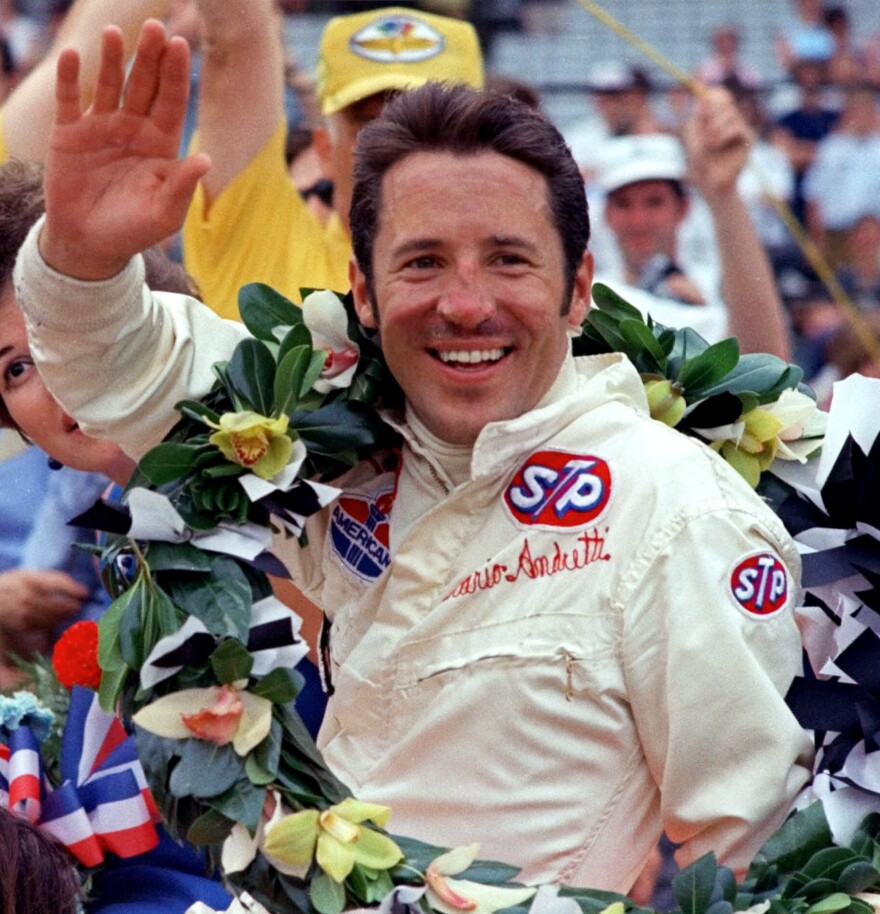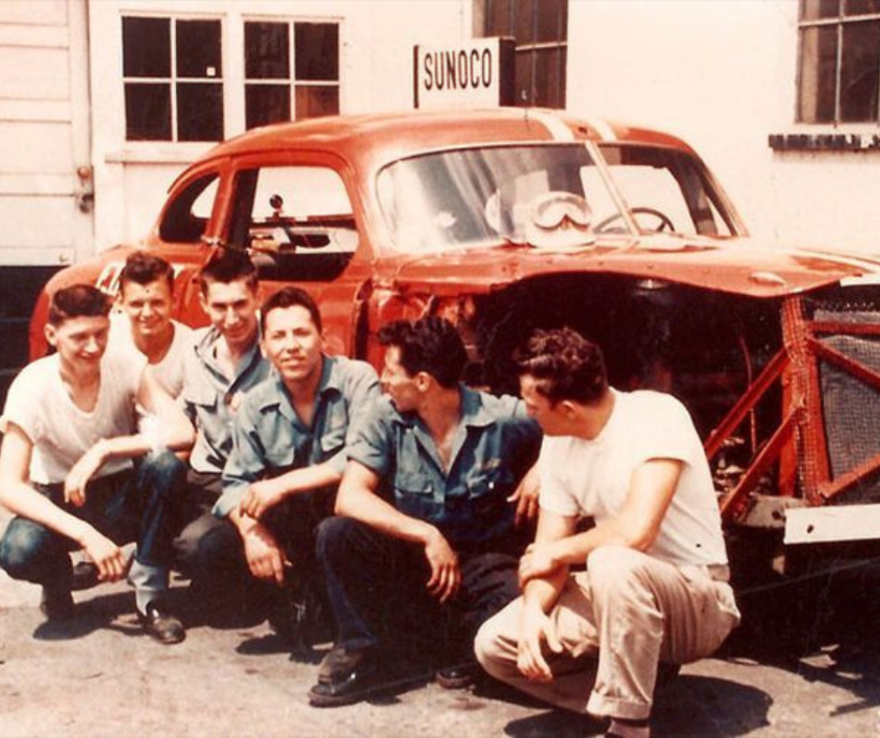UPPER NAZARETH TWP., Pa. — At race tracks and grocery stores.
On golf courses and at gas stations.
In real life and in his dreams.
Mario Andretti knows it’s coming and accepts he’s powerless to stop it.
Much as if he were blanching at dark clouds and rolling thunder in the distance, the greatest race car driver in history braces for the question racing toward him.
The question — constant and predictable — is this:
Mario, tell me about winning the Indianapolis 500?

Despite Andretti winning the IndyCar national championship four times, the Daytona 500 and the 1978 Formula One world championship — the latter the racing achievement he views as his most memorable — it’s always about Indy.
Despite having won 110 other races at virtually every venue over five unequaled decades, it's always about Indy.
Despite him being voted Driver of the Century, and despite being named Driver of the Year in three different decades, and despite being the only driver in history to win races in five different decades and despite winning every race from Nazareth to the Netherlands, it’s always about Indy.
“Yeah, you know, it’s actually somewhat irritating,” said Andretti, 84, while seated in an office at La Villa de Montona, his sprawling estate in Nazareth named for the northern Italian town of his birth.
“I understand the interest, sure, and it was a big win in my career," he continued. "But it’s irritating to me because I won national championships and a world championship. But when people meet me, all they want to talk about is Indy. Indy. Indy.”
"I got fan mail from somebody in Tibet. Tibet!"
Andretti expresses his irritation kindly. He knows he cannot change the “Tell me about Indy” reality. Better to try to halt the tides. He seems forever resigned to being da Vinci informing those asking about his Mona Lisa ad nauseam, “You know, I have painted other things.”
However, Andretti acknowledges the magnitude of winning the Indianapolis 500 — even if just once in 29 tries — is akin to winning The Masters in golf and Wimbledon in tennis. Success in those events practically transcends the sports themselves.
“Indy’s got that signature,” he said. “It’s like a big, big feather in any driver’s cap. Listen, I get it. It’s Indy.”
It’s not as if Andretti fails to embrace the significance of his accomplishment; he does. Had that somehow escaped him, legions of fans are here to remind him.
Andretti’s full understanding of the incredible reach of his Indy 500 win came not at the mall but in the mail.
“I got fan mail from somebody in Tibet,” he said. “Tibet! That’s the first time I heard from somebody that far away about Indy. That shows just how important Indy is. Winning Indy is life changing.”

Uneven road to victory
Fifty-five years ago on Sunday, 29-year-old Andretti roared into auto racing history by winning the Indianapolis 500.
His prior history of bad breaks at the event preceded 1969. But even then, during a practice run, the black cats were everywhere. He totaled the Lotus 64, his primary car, when he crashed into a wall. He sustained facial burns and, it was presumed, lost any realistic chance at victory.
But he finally won that race. The Race. The Greatest Spectacle in Racing, as it is known. Doing so for 500 miles on the same right rear tire worn to the threads because it refused to come off during a pit stop. Being shocked by the unexpected Victory Lane wet kiss on the cheek by car owner, the late Andy Granatelli, of STP fame and two dozen Indy disappointments. All of it is cemented in Indy 500 and auto racing lore.
“It was great to win Indy,” Andretti said. “But I was just so happy for Andy. He had wanted to win Indy for so long. I was happy to do it for him.”
Widespread interest in Andretti’s Indy victory during a year highlighted by man’s first steps on the moon, Woodstock and the Manson murders does not wane. He is a Beatle with a string of hits but first and forever being asked about that magical night on Ed Sullivan.
Fit, tan and with a thick head of hair best found on a teenager, Andretti is surrounded by framed photographs of his racing career and family that hang on his office walls. On a wall behind him and to his left is a replica of the silver Indianapolis 500 winning trophy attached to a wooden plaque.
Andretti recalls that historic day at Indianapolis Motor Speedway before 275,000 fans and a worldwide television audience. He leans forward in his chair and works his thick hands together as if massaging his memory from slumber.
More than a half-century after Indy — a victory achieved so long ago the cellphone and Post-It notes had not yet been invented — Andretti imparts minute details of the race and the days leading up to it.
“There were a couple days of rain that delayed the time trials,” he recalled. “We arrived at Indy with state-of-the-art equipment. We had the Lotus, which was four-wheel drive and a derivative of the turbine cars, with a very advanced type of chassis.
“In practice I went very fast and was breaking some records. Two days before qualifying, the right-rear wheel hub sheared off, and I had a huge crash in Turn 4.
“There was fire and everything else. I was lucky to escape with just some burns on my face and lip. I could have inhaled some flames, but I jumped out of the car and kind of rolled around. I was lucky.”
Andretti believed the Andretti jinx had reared its head once again. When his backup Lotus car was withdrawn, as were all Lotus cars due to mechanical safety issues following Andretti’s crash, he was left to drive the turbocharged yet sketchy Ford-V-8-powered Brawner-Hawk III, which he had guided to victory a month earlier at a USAC championship race in Hanford, Calif.
With only a day-and-a-half of practice time in the Hawk, Andretti qualified on the front row between pole-sitter and rival A.J. Foyt and Bobby Unser, a duo that would win Indy a combined seven times.
“We had overheating issues with the Hawk,” Andretti recalled. “That was the concern.
“Because I was running 270-degree oil temperature the whole race, I was worried. But I backed off to keep the temperatures low. I was playing it smart.”
When Foyt, his main rival, Roger McCluskey and Lloyd Ruby experienced driving issues, Andretti coaxed the Hawk to the checkered flag, besting Dan Gurney by less than two minutes.
Andretti’s finish time of just over three hours, 11 minutes was an Indy 500 record to date, breaking the previous record by nearly five minutes.
The Hawk's performance and Andretti's wise handling of the cranky racecar landed Andretti in Victory Lane and the red No. 2 car in the Smithsonian.
The only Indy winning car in the museum.
The winning wreath hung from Andretti's neck. The sweet smile of victory frozen on his face. A slug from the traditional bottle of ice cold milk. And the shock of feeling Granatelli grab him and plant one on his cheek.
“That was Andy,” he said. “He was just so happy.”
‘God guides everything’
As yet another Indy 500 approaches, Andretti teetered on figurative tip-toes, looking beyond his historic racing fence — at 1969 and earlier.
He spoke of his family’s emigration on June 16, 1955, from an Italian territory that is now Croatia to Nazareth.
Three days later, he and his late twin brother, Aldo, were drawn by the lights and lion’s roar of cars at nearby Nazareth Speedway. They were transfixed on the action. Soon they were racing there, in a car they built, in their adopted home, where the Andretti legend was born.

“Some people believe that God guides everything,” Andretti said, nodding. “So, we come to America and end up in Nazareth. And Aldo and I love racing. And there’s a race track right down the street.
“You know what I’m saying here? Imagine it. God moves you where you belong.”
‘Uncle Louie’
God, if Andretti is correct, brought him to Uncle Louie.
Louis Messenlehner was an uncle on his mother’s side. He lived in Nazareth. He helped their father find work and helped the twins learn English and — clandestinely because their parents disapproved of auto racing — helped them assemble a modified stock car of their own.
And then, in 1958, there is the memory of a car ride that Andretti will never forget.
“Uncle Louie took Aldo and me to Indianapolis in 1958,” he said. “We drove straight out. We slept in the car right next to the track. He bought us seats in Turn 4.
“After the race, we walked on the track. It was like a mecca. It was like one of those dream things. I stood on that track, looked around and said, ‘Someday, I’m gonna race here and win.’”
‘I’m the only one they’re looking at’
Fifty-five years later, Andretti remains struck by the pageantry at Indy. The intoxicating hype leading up to race day. The crush of media the world over. The interviews. The photo ops. The parades. For a driver who entered the 1969’s race laser-focused on reversing past failures, the key was blocking out the distractions.
“I don’t know how anyone can prepare you for that, especially for drivers there for the first time,” Andretti said. “You just have to try to stay calm and roll with the punches.
“But it really got to me on qualifying day. We used to get 200,000 people in those days. When I left the pits, I looked up and thought, ‘Holy (expletive)! I’m the only one they’re looking at!’ All eyes were on me.
“But then as soon as I get in the cockpit and get up to speed, it all disappears. Then, it’s about racing.”
Success and sadness
Andretti stood before a room filled with what seems like hundreds of trophies won all over the world. He opens a glass door, removes a trophy and remembers everything about the win in detail. He does this again and again.
As he lifts the Indy 500 trophy and smiles for a photo, he’s 29 again.
“Each one tells a story, right?” he said. “In so many ways, they do. To me, it brings back fond memories, no question.”
Had Andretti continued with every award there, he’d have finished right about the time he turned 100.
He raises his eyebrows and grins. Mario Andretti — the best behind the wheel that there’s ever been — is reminded of his good life that got the green flag in Nazareth.
Oh, there’s been sadness mixed with his gaudy success. The racing deaths of pals Ronnie Peterson, and Red Riegel and Jud Larson in the same accident at Reading Speedway in 1966. The accident at a race in Hatfield, Montgomery County, that left Aldo in a coma for months, and another in Des Moines, Iowa in which he was nearly killed.
And, of course, the death of wife, Dee Ann, an Allentown native, six years ago.
Andretti’s regrets are few. The deepest is that his father did not live long enough to see him become knighted by the Italian government.
Andretti stares at the framed certificate on a wall near an office back door. His expression is a blend of pride and melancholy.
“My father,” he said, forlornly, “would have been so proud.”
Mario Andretti celebrates 55 years since his teenage vow to race and win at Indianapolis came true.
Mario Andretti, who came to America with his family and just $125 to their name, felt Nazareth’s warm arms of acceptance and never for a second ever thought of leaving his adopted home.
Mario Andretti, who in 2006 had a celestial star named after him.
Years after he first became one.
Never misses Indy
Another Indianapolis 500 is nearly upon us. As Andretti ventures out of his estate packed with so much racing success, he knows the question is coming.
This year, Andretti arrived in Indianapolis weeks before the race, participating in race-related activities nearly every day.
Every year on race day since his retirement, Mario Andretti will be where he has always been every Memorial Day weekend — at Indy. Watching on TV is for others; he needs to feel the roar of the engines. At trackside.
Because even for him at this time of the year, it’s all about Indy.
A reality that's not the least bit irritating.



















